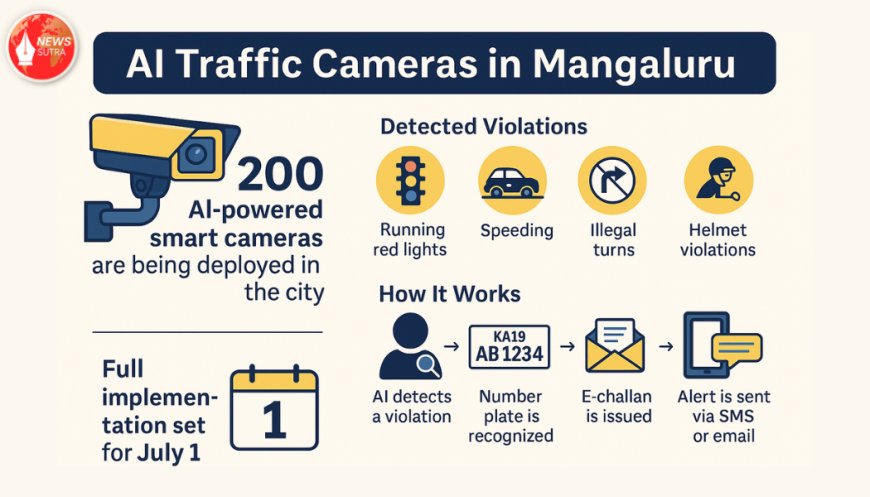Mangaluru’s AI Traffic Overhaul: 200 Smart Cameras Go Live to Curb Violations, Full Rollout by July 1
Mangaluru rolls out 200 AI-powered smart traffic cameras to detect violations and issue real-time alerts. Full enforcement begins July 1 under Smart City Mission.

MANGALURU, KARNATAKA — In a significant leap toward smarter urban management, the city of Mangaluru has officially begun the phased rollout of 200 AI-powered smart traffic enforcement cameras, designed to automatically detect violations and dispatch digital alerts in real time. With full implementation slated for July 1, 2025, the project promises to overhaul road safety standards across the coastal city.
The initiative, part of the broader Mangaluru Smart City Mission, is being deployed in coordination with the Mangaluru City Traffic Police (MCTP) and Karnataka State Road Transport Department, aligning with the national push toward AI-driven infrastructure and smart surveillance.
What Makes These Cameras Smart?
These aren’t just any traffic cameras. Backed by AI-based video analytics, the 200 units are capable of:
-
Real-time violation detection, including red light jumping, speeding, illegal turns, lane indiscipline, and helmet-less riding
-
Automatic Number Plate Recognition (ANPR) integrated with Vahan and Sarathi databases
-
Instant generation and delivery of e-challans via SMS or email to registered vehicle owners
-
Facial recognition for identifying repeat offenders in specific high-risk zones
These smart systems are connected via a central command center that leverages AI and machine learning algorithms to process traffic movement patterns and anticipate potential congestion hotspots.
To learn more about how ANPR and AI analytics are transforming road safety, visit Siemens Mobility.
Why Mangaluru?
Although Mangaluru is better known for its serene beaches and port economy, it has become a rising example of smart urbanization in India. This deployment makes it one of the first tier-2 cities in Karnataka to implement AI-powered automated traffic enforcement at scale.
According to DCP (Traffic) M.V. Hariram, the move addresses increasing traffic violations, particularly during peak hours:
“We’ve seen a surge in both vehicle volume and non-compliance. These AI cameras will not only catch violations but help us analyze behavioral trends, informing better city planning.”
The 200 locations were selected after a comprehensive study using GIS mapping, accident frequency data, and vehicular load analytics.
Full Implementation by July 1
While 120 cameras have already gone live at critical junctions including Kankanady Circle, Nanthoor Junction, and Bunder Road, the remaining 80 will be operational by July 1, 2025, in accordance with the final Smart City infrastructure compliance phase.
The Mangaluru Smart City Ltd (MSCL) has confirmed the integration of these cameras into a citywide Integrated Traffic Management System (ITMS), supported by optical fiber backhaul and secure cloud-based storage for evidence archiving.
See the official Smart Cities Mission dashboard for updates on Mangaluru’s digital infrastructure performance.
How It Works: The End-to-End Process
-
Detection: AI identifies violation in real-time via edge-processing
-
Recognition: ANPR reads vehicle number and matches with RTO database
-
Validation: Violation clips are screened automatically and flagged for review
-
Alert: E-challan generated and sent via Parivahan Sewa to violator
-
Appeal Option: Citizens can review footage and contest through online portals
To review or pay fines, residents can visit the official Parivahan e-Challan portal.
Public Awareness and Impact
The city authorities are conducting awareness drives in local schools, colleges, and commercial zones to inform residents of the system’s capabilities and encourage voluntary compliance. Additionally, billboards and LED signage now display real-time violation counts at major intersections.
Initial findings from the pilot phase revealed:
-
40% drop in red-light jumping at signalized junctions
-
25% increase in helmet compliance
-
Improved flow at 15 congested intersections
Experts from the National Institute of Urban Affairs (NIUA) are analyzing the impact to potentially replicate this model in cities like Hubballi, Mysuru, and Belagavi.
Explore related urban transformation insights at NIUA's official research archive.
Challenges Ahead
Despite early success, officials acknowledge hurdles:
-
Privacy concerns: Ongoing dialogue with digital rights groups ensures data protection and usage transparency.
-
Appeal backlog: A surge in contested challans is being addressed by deploying more staff and expanding digital support.
-
Weather resilience: Monsoon-proofing measures have been implemented with camera hoods and sealed fiber cabling.
To tackle these concerns, the Karnataka Digital Infrastructure Agency (K-DIA) is consulting with experts on AI ethics, urban law, and transparency protocols.
A Vision for Safer Cities
With Bengaluru and Pune already leading in AI-enforced traffic safety, Mangaluru is setting an example for medium-sized cities. The city’s approach reflects a shift from manual policing to predictive, data-driven enforcement that prioritizes both efficiency and deterrence.
In the long run, these AI systems may even feed data into urban mobility dashboards, helping plan new roads, pedestrian crossings, and transport routes more efficiently.
Final Thoughts
Mangaluru’s adoption of AI-powered traffic enforcement represents a critical turning point in its evolution as a smart, responsive, and secure city. With a solid roadmap, proactive governance, and growing public support, the success of this project may well define how India’s cities manage traffic in the AI era.











